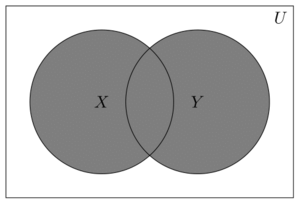Difference between revisions of "Unions"
Jump to navigation
Jump to search
Scott Roby1 (talk | contribs) (Created page with "== Definition == Let <math>X</math> and <math>Y</math> be subsets of some universal set <math>U</math>. The '''''union of <math>X</math> and <math>Y</math>''''', written <math...") |
Scott Roby1 (talk | contribs) |
||
| Line 1: | Line 1: | ||
== Definition == | == Definition == | ||
| + | [[File:Union.png|thumb|The Venn diagram displays two sets <math>X</math> and <math>Y</math> with the union <math>X\cup Y</math> shaded]] | ||
Let <math>X</math> and <math>Y</math> be subsets of some universal set <math>U</math>. The '''''union of <math>X</math> and <math>Y</math>''''', written <math>X\cup Y</math>, is the set of all <math>x</math> in <math>U</math> which are in at least one of the sets <math>X</math> or <math>Y</math>.<br /> | Let <math>X</math> and <math>Y</math> be subsets of some universal set <math>U</math>. The '''''union of <math>X</math> and <math>Y</math>''''', written <math>X\cup Y</math>, is the set of all <math>x</math> in <math>U</math> which are in at least one of the sets <math>X</math> or <math>Y</math>.<br /> | ||
Symbolically, <math>X\cup Y=\lbrace x\in U : x\in X \text{ or } x\in Y\rbrace</math>. | Symbolically, <math>X\cup Y=\lbrace x\in U : x\in X \text{ or } x\in Y\rbrace</math>. | ||
Latest revision as of 12:05, 29 June 2015
Definition
Let and be subsets of some universal set . The union of and , written , is the set of all in which are in at least one of the sets or .
Symbolically, .
Examples
Example 1
Determine the union of the sets and .
Solution By definition, we wish to find the set of all elements which are in at least one of the two sets. Thus, we will collect all unique elements into a set as long as they appear once or more between the sets. Our solution is .
Example 2
Prove that for any sets and , .
Proof Let . We wish to show that , so this means showing that such that or . Since , we have that and by definition of we know that . Thus the “or” statement is true and hence . This shows that .















